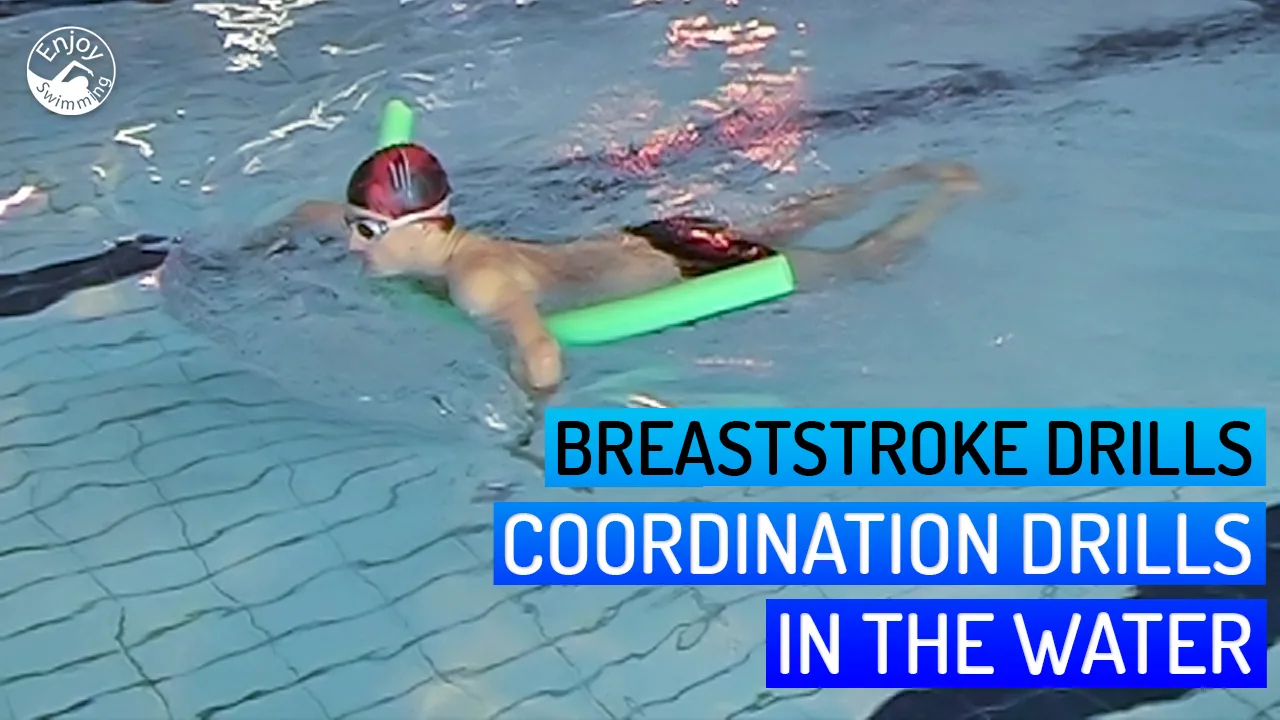This article to learn swimming breaststroke covers drills to coordinate arm movements, leg movements and breathing.
This article is the last part of our series to learn breaststroke.

As you can see in the video below, a swimming noodle is used. It provides additional buoyancy to your body in the water, but also allows your arms and legs to move without constraints.
Demonstration Video
The following video demonstrates the drills described in this article:
The swimming drills are explained in more detail below.
Swimming Breaststroke using a Water Noodle, without Breathing
In this drill to learn swimming breaststroke, you will have to coordinate your arm and leg movements for the first time. Getting this coordination right can take some time to master.
Do the following to get started:
- Grab a water noodle (or two if you need additional support in the water).
- Go to the shallow area of the pool.
- Place the water noodle(s) across your chest and under your armpits.
Now get into the initial glide position:
- Push off the ground and assume a horizontal position with your body.
- Your arms are extended forward, and your hands are close together.
- Your legs are extended, close together, and your toes are pointed.
- Your face is in the water, and your head is aligned with your trunk.
- You’ll keep your head in the water for the whole stroke cycle.
Now start the stroke cycle:
- As explained in learning the arm movements on dry land, start the arm stroke with the outsweep, followed by the catch and insweep.
- Start the recovery of the legs towards the buttocks at the end of the arms’ insweep, then catch and sweep out with your legs at the end of the arms’ recovery forward. The legs’ movements are explained in more detail in this breaststroke kick article.
- Your legs continue to sweep out and then in while your arms are extended forward.
- At the end of the kick, observe a short glide phase in the streamline position where both your arms and your legs are extended and kept together.
- Start the stroke cycle again after the glide phase by sweeping your arms out.
- Do three stroke cycles in a row, then pause for breathing, before starting again.
- Practice until you get the timing between your arm movements and leg movements right.
Swimming Breaststroke using a Water Noodle, with Breathing
Our final drill to learn swimming breaststroke adds breathing. Do the following:
- Follow the same instructions like for the previous drill.
- However, when you start to sweep in with your arms, let your hips drop and your shoulders and head rise above the water surface.
- Start to inhale as soon as your mouth clears the water.
- Still, keep your head in line with your trunk. Look downwards and slightly forward.
- Let your shoulders and head drop back into the water when your arms recover forward. Start to exhale as soon as your head is in the water again.
- Finish this stroke cycle, then immediately start a new one, and so on. You are now swimming breaststroke while being supported by a water noodle.
- Practice this until the coordination between the arm movements, leg movements and breathing feels natural.
Finally Swimming Breaststroke
Once you feel confident enough in the propulsion and support provided by your arms’ and legs’ movements you can remove the water noodle. Congratulations! You are now swimming breaststroke!
It is advisable to stay in the shallow area of the pool until you have built up confidence and endurance. Then, when you want to venture into the deep area of the pool, it is advisable to inform the lifeguard so that (s)he can keep an eye on you.
You can also fall back on using your trusted water noodle until you feel comfortable being in the deep area of the pool. Remember always to stay safe!
Lots of success with your new swimming abilities!
Learning Path for the Breaststroke
Below is an overview of our series of articles on learning the breaststroke. Each article in this series contains one or more drills that have to be mastered. The current article is highlighted:
Once you have gone through all the steps of this learning path, you should be able to swim breaststroke without any problems.
Good luck!

jk
Saturday 7th of July 2018
Must it not be so: arms' in-sweep and legs recovery are done at the same time. Then the arms recover forwards before feet catching and thrusting and legs squeezing.